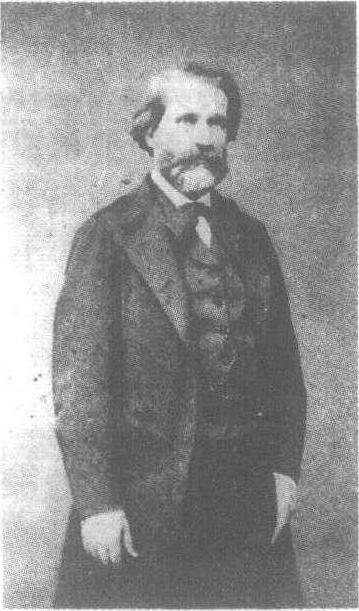威尔第1813—1901G. Verdi
意大利作曲家,生于意大利布塞托城。幼年即显露音乐才能,随乡村乐师学奏风琴。1836年到米兰,向斯卡拉歌剧院指挥拉威纳学作曲。1839年,第一部歌剧《奥伯托》演出获得成功。1842年,表现被奴役的犹太人生活的歌剧《那布可》公演,激起意大利人民的爱国热情,威尔第自此确立了他在乐坛的地位。至1850年,他先后写出10余部歌剧,在意大利民族解放运动中起过鼓舞的作用。1851年,创作进入盛期,完成了《弄臣》(1851年)、《游吟诗人》(1853年)、《茶花女》(1853年)等名作。晚期作品中,1871~1872年为苏伊士运河通航而写的《阿伊达》,以及根据莎士比亚剧作写的《奥塞罗》(1887年)和《法尔斯塔夫》(1893年,即《温莎的风流娘儿们》)都是炉火纯青之作。威尔第一生写了26部歌剧,他创作了许多接近意大利民歌的优美而动人心弦的曲调。他善于刻画人物的性格和内心活动。他作品的乐队部分具有浓郁的色彩,在烘托及渲染剧情方面具有强烈的效果,这些特点使他成为音乐史上最受欢迎的歌剧作曲家之一。
威尔第1813—1901WeierdiG·Verdi
意大利歌剧作曲家。1813年10月10日生于意北部商业城镇布塞托附近的隆科莱(Roncole)。其父在村里开小旅店并兼售日用杂货。威尔第幼年时,1814年俄、奥军队经过意大利,一小股军人闯入隆科莱,到处烧杀抢掠,其母抱小威尔第躲在教堂钟楼里面,才保护这位歌剧的奇才大师免遭劫难。威尔第少年时代即显露超人的音乐才能,7岁时,曾由于倾听教堂弥撒曲,而忘掉把水送到神父手里,而遭到神父的怒责,把他一脚从神坛上踢下来,他央求父亲说:“让我学习音乐吧!”父亲以他微薄的收入为儿子买了一台旧钢琴,并师从学习音乐知识及钢琴,后来父亲送他去布塞托读书,至十二岁每天往返布塞托和隆科莱之间,为了每年40里拉的收入,为教堂弹奏风琴。有一次圣诞之夜由于天寒风雪交加,为了赶路的威尔第竟跌进一条河里,后被人救起,已四肢冻僵,险些丧命。后来其父结识了城内富商巴雷齐,巴雷齐热爱音乐,后吸收威尔第在他店内工作,威尔第得以更多地接触音乐,他在布塞托和当地乐团指挥普罗维希学习音乐。在他16岁时,普罗维希把风琴师及乐团指挥的职位,都交给了威尔第。这时他写了不少歌曲、钢琴曲及其它宗教歌曲和乐曲,在镇上已小有名气。他18 (1832年)岁时去米兰报考音乐学院,但未被录取(主要由于年龄大大超过该院14岁的限制年龄)。于是他只能成为歌剧作曲家拉维尼亚的私人学生。1939年他的第一部歌剧《波尼法西奥伯爵奥贝托》在斯卡拉歌剧院首演成功。该歌剧院领导梅雷利对威尔第的才华异常赏识,当即邀他再写三部歌剧,但他第一部歌剧《王国的一天》并不成功,再加上他的妻子和两个孩子相继去世,给威尔第精神上打击极大,他发誓今世不再作曲。经梅雷利多次劝说,并拿来歌剧剧本《纳布柯》给他看,他深为剧中主人公的爱国主义精神所感动,再次振作精神把《纳布柯》写出,又一次获得巨大成功,其中的合唱“希伯莱奴隶合唱”《在幼发拉底河岸》更是家喻户晓,脍炙人口,成为流传至今久唱不衰的名作。并与剧中女主角女高音歌唱家斯特雷波尼结为夫妇。威尔第自己在日记中写道:我的作曲生涯可以说是从这一部歌剧开始的”。在这以后8年间,威尔第先后创作并演出了13部歌剧,每年都有新作上演。他的歌剧气势宏伟,激动人心,剧中歌曲旋律优美、真挚感人。当时意大利正处于外国的统制之下,意大利人深深感到威尔第的歌剧表达他们不愿作奴隶,求得自由解放的心声。充满着爱国主义激情。像《纳布柯》、《麦克白》、《莱尼亚诺之战》等都是爱国主义主题。在此之后威尔第的成功之作有《弄臣》、《茶花女》、《游吟诗人》和《阿依达》等。都是意大利歌剧史上的里程碑,成为世界歌剧宝库必不可多得的珍宝。之后他又写了最后两部歌剧《奥赛罗》和《法斯塔夫》已进入八旬的高龄了,这两部歌剧开拓了意大利歌剧的创作之路,成为后人创作的楷模。1901年1月21日他突然患中风半身不遂。27日与世长辞,终年86岁。意大利政府为表彰他在歌剧事业上的巨大贡献,以隆重的民族英雄光荣称号举行了葬礼。

威尔第
威尔第 (1813—1901),意大利作曲家,生于意大利布塞托城。幼年即显露音乐才能,随乡村乐师学奏风琴。1836年到米兰,向斯卡拉歌剧院指挥拉威纳学作曲。
1839年,第一部歌剧 《奥伯托》 演出获得成功。1842年,表现被奴役的犹太人生活的歌剧 《那布可》 公演,激起意大利人民的爱国热情,威尔第自此确立了他在乐坛的地位。至1850年,他先后写出10余部歌剧,在意大利民族解放运动中起过鼓舞的作用。1851年,创作进入全盛时期,完成了 《弄臣》 (1851)、《游吟诗人》 (1853)、《茶花女》 (1853) 等名作。晚期作品中,1871—1872年为苏伊士运河通航而写的 《阿伊达》,以及根据莎士比亚剧作写的 《奥塞罗》 (1887) 和《法尔斯塔夫》 (1893),即 《温莎的风流娘儿们》 都是炉火纯情之作。
威尔第一生写了26部歌剧,他创作了许多接近意大利民歌的优美而动人心弦的曲调。他善于刻画人物的性格和内心活动。他作品的乐队部分具有浓郁的色彩,在哄托及渲染剧情方面具有强烈的效果,这些特点使他成为音乐史上最受欢迎的歌剧作曲家之一。
威尔第
威尔第(1813—1901),意大利作曲家,生于意大利布塞托城。幼年即显露音乐才能,随乡村乐师学奏风琴。1836年到米兰,向斯卡拉歌剧院指挥拉威纳学作曲。
1839年,第一部歌剧《奥伯托》演出获得成功。1842年,表现被奴役的犹太人生活的歌剧《那布可》公演,激起意大利人民的爱国热情,威尔第自此确立了他在乐坛的地位。至1850年,他先后写出10余部歌剧,在意大利民族解放运动中起过鼓舞的作用。1851年,创作进入全盛时期,完成了《弄臣》 (1851)、《游吟诗人》 (1853)、《茶花女》(1853)等名作。晚期作品中,1871—1872年为苏伊士运河通航而写的《阿伊达》,以及根据莎士比亚剧作写的《奥塞罗》(1887)和《法尔斯塔夫》 (1893),即《温莎的风流娘儿们》都是炉火纯青之作。
威尔第一生写了26部歌剧,他创作了许多接近意大利民歌的优美而动人心弦的曲调。他善于刻画人物的性格和内心活动。他作品的乐队部分具有浓郁的色彩,在烘托及渲染剧情方面具有强烈的效果,这些特点使他成为音乐史上最受欢迎的歌剧作曲家之一。
威尔第
意大利作曲家。1813年10月10日生,1901年1月27日去世。1938年创作第1部歌剧,50年代进入成熟期。创作歌剧27部,歌曲16首,合唱曲7首等。主要作品:歌剧《麦克白》(1846~1847)、《假面舞会》(1857~1858)、《命运的力量》(1861)、《阿伊达》(1870)、《奥赛罗》(1884~1886)、《法尔斯塔夫》(1889~1893),合唱曲《圣母颂》(1879~1880)、歌曲6首《浪漫曲》(1838)等。